The world of cryptocurrency is constantly evolving, offering new ways to interact with your digital assets and potentially generate passive income. One such method gaining traction is crypto lending, a process where you can either earn interest by lending your crypto or borrow funds using your crypto as collateral. This article delves into the intricacies of crypto lending, exploring its benefits, risks, and how it can fit into your crypto investment strategy.
What Is Crypto Lending?

Crypto lending refers to the practice of lending digital assets to earn interest or borrowing them for various purposes. Unlike traditional lending systems, crypto lending operates on blockchain technology, ensuring transparency, security, and decentralization. Participants in crypto lending include lenders, who provide their digital assets, and borrowers, who seek to borrow these assets.
What Is a Crypto Lender?
A crypto lender is an individual or entity that lends digital assets to borrowers. These lenders play a crucial role in the crypto lending ecosystem, providing liquidity to the market while earning interest on their holdings. Crypto lenders can be individuals, institutional investors, or even automated protocols within decentralized finance platforms.
Crypto Lending for Borrowers
Borrowers in the crypto lending space are individuals or entities seeking to borrow digital assets for various purposes. This could range from short-term trading strategies to obtaining liquidity without selling their crypto holdings. Crypto lending offers borrowers a decentralized and efficient alternative to traditional lending, with lower barriers to entry and faster processing times.
Crypto Lending for Investors
For investors, crypto lending presents a unique opportunity to earn passive income on their digital assets. By lending out their cryptocurrencies, investors can earn interest over time, potentially outperforming traditional investment vehicles. The returns on crypto lending can vary based on factors such as the platform used, the type of digital assets lent, and market conditions.
What Is DeFi Lending?
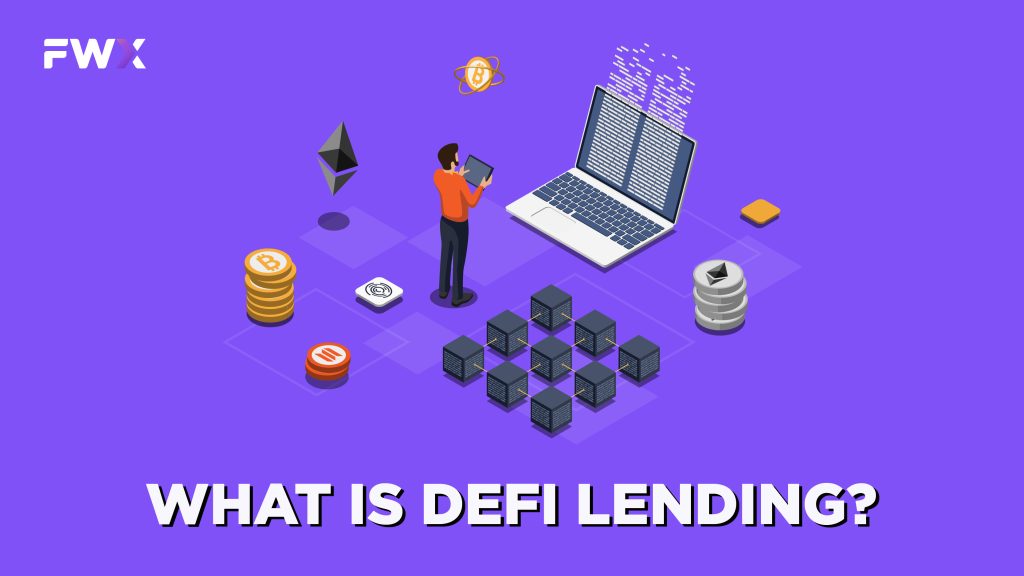
DeFi lending, short for decentralized finance lending, is a system for borrowing and lending cryptocurrency in a peer-to-peer (P2P) manner, without the need for intermediaries like banks. It involves using DeFi platforms built on blockchain technology, eliminating the traditional financial system’s centralized control and allowing for flexible interest rates and terms.
Key features of DeFi lending:
- Decentralization: No central authority controls the platform.
- Transparency: All transactions are recorded on the blockchain and openly viewable.
- Flexibility: Users can choose loan terms and interest rates.
- Accessibility: Anyone with a crypto wallet can participate.
- Potential for higher yields: DeFi lending can offer higher interest rates than traditional banks.
How Does DeFi Lending Work?
DeFi lending works like a peer-to-peer marketplace for borrowing and lending cryptocurrencies, cutting out the middleman (banks) and offering more flexible terms and potentially higher yields. Here’s a breakdown of the process:
For lenders:
- Deposit your crypto: You deposit your cryptocurrency, like Ether (ETH) or USD Coin (USDC), into a liquidity pool on a DeFi lending platform. Think of it like a big pot of money everyone contributes to.
- Earn interest: Your deposited funds are used to lend to borrowers, and you earn interest on your contribution based on supply and demand. The more people borrowing from the pool, the higher the interest rate you can potentially earn.
- Collateralized loans: Your funds also act as collateral (security) for borrowers. This helps to mitigate the risk of borrowers defaulting on their loans.
For borrowers:
- Deposit collateral: To borrow crypto, you need to put up some of your own cryptocurrency as collateral. This is usually more than the loan amount you want to borrow, like 150% or 200%. It’s like putting down a deposit when you rent an apartment.
- Borrow crypto: Once you’ve deposited collateral, you can borrow cryptocurrency from the pool. You’ll pay interest on the loan, and the interest rate is often determined by the type of crypto you borrow and the amount of collateral you put up.
- Repay the loan: You need to repay your loan with interest within the agreed-upon timeframe. If you can’t repay the loan, your collateral may be liquidated (sold) to cover the outstanding debt.
Defi Lending vs. Traditional Lending
Here’s a breakdown of the key differences between DeFi lending and traditional lending:
| Feature | DeFi Lending | Traditional Lending |
| Structure | Decentralized, P2P | Centralized, institutional |
| Accessibility | Open to everyone | Credit checks, income verification |
| Interest Rates | Variable, potentially higher | Fixed or variable, generally lower |
| Benefits | Higher potential returns, faster approval, control over funds | Lower risk, established framework, insured deposits |
| Risks | Volatility, smart contracts, platform hacks, no oversight | Debt burden, foreclosure, high fees, limited control, predatory practices |
Pros and Cons of DeFi Lending
Pros:
- Decentralization: DeFi lending operates on blockchain networks, ensuring a decentralized and trustless environment.
- Accessibility: DeFi lending is open to anyone with an internet connection, promoting financial inclusivity.
- Transparency: Transactions on the blockchain are transparent and verifiable, providing a high level of transparency.
- Reduced Costs: By eliminating intermediaries, DeFi lending often incurs lower fees compared to traditional lending.
Cons:
- Smart Contract Risks: Smart contracts, while designed to be secure, can still be vulnerable to exploits or bugs.
- Market Volatility: The value of digital assets can be highly volatile, impacting the value of collateral and the overall stability of the lending platform.
- Regulatory Uncertainty: The regulatory landscape for DeFi is still evolving, leading to uncertainty and potential regulatory challenges.
Crypto Lending vs Staking
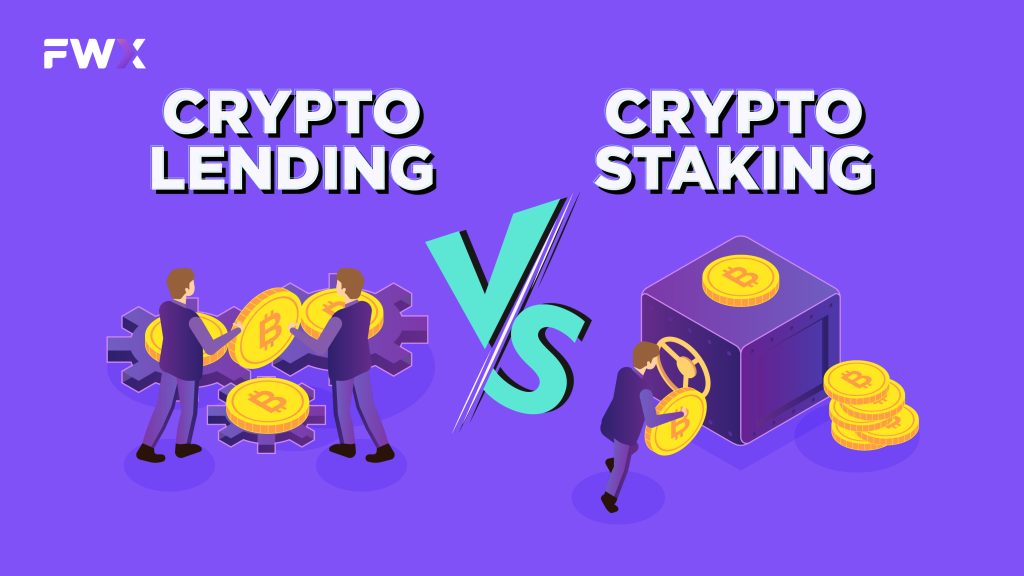
Crypto lending and staking are both ways to generate passive income with your cryptocurrency, but they operate in fundamentally different ways and offer distinct advantages and disadvantages. Here’s a breakdown:
Crypto Lending:
- Mechanism: You lend your crypto to other users through a DeFi platform. They use your coins for various purposes, like margin trading or short-term liquidity needs.
- Returns: You earn interest on your loaned crypto, typically paid in the same currency you lent. Interest rates are dynamic and fluctuate based on demand for the borrowed asset.
- Risks: Your primary risk is borrowing default, where the borrower fails to repay their loan. The platform may liquidate their collateral to cover the debt, but you might not recover your full amount. Other risks include platform hacks, smart contract vulnerabilities, and volatility of the underlying asset.
Staking:
- Mechanism: You lock your crypto in a blockchain network supporting the Proof-of-Stake (PoS) consensus mechanism. Your coins contribute to validating transactions and securing the network, earning you rewards.
- Returns: You receive staking rewards in the same token you staked, typically calculated as a percentage of your staked amount. Reward rates are usually fixed or predictable.
- Risks: The primary risk is cryptocurrency price volatility. If the value of your staked asset drops, your overall investment might decrease. Other potential risks include smart contract vulnerabilities and slashing penalties for validator misbehavior.
How Does Crypto Lending Work?
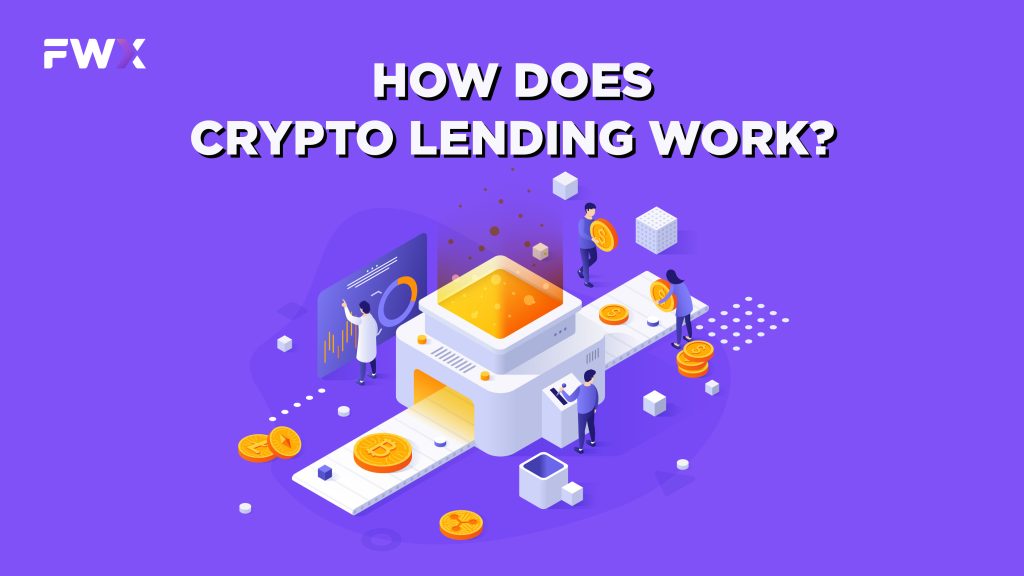
Crypto lending operates through a peer-to-peer (P2P) system facilitated by decentralized platforms built on blockchain technology. It functions like this:
1. Depositing & Lending:
- Lenders: Deposit their crypto into a lending pool on a platform.
- Platform: Matches lenders’ deposited funds with borrower requests.
- Borrowers: Deposit collateral (usually more crypto than the loan amount) to secure the loan.
- Interest: Borrowers pay interest on the loaned crypto, determined by supply and demand.
- Lenders: Earn interest on their deposited crypto based on the platform’s algorithm and market rates.
2. Borrowing & Repaying:
- Borrowers: Receive loaned crypto from the pool and use it for various purposes like margin trading, short-term liquidity needs, or yield farming.
- Repayment: Borrowers must repay the loan with interest within the agreed-upon timeframe.
- Collateral Management: If a borrower fails to repay, their collateral may be liquidated (sold) to cover the outstanding debt.
Crypto Lending Use cases
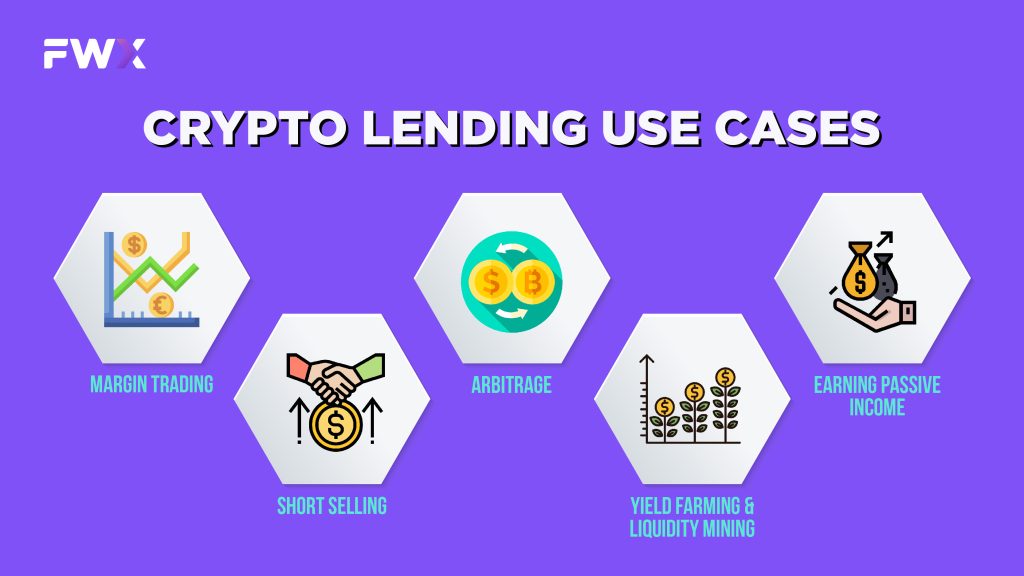
Crypto lending has evolved as a significant use case within the broader cryptocurrency and blockchain ecosystem. Here are some notable use cases for crypto lending:
- Margin Trading:
Borrowing for Leverage: Traders can borrow cryptocurrencies to amplify their trading positions through margin trading. This allows them to potentially increase profits (or losses) by using borrowed funds to trade larger positions than their own capital allows.
- Short Selling:
Borrowing for Short Positions: Traders can borrow cryptocurrencies to sell them at the current market price with the expectation of buying them back later at a lower price. This is known as short selling and is a way to profit from a decline in the value of a cryptocurrency.
- Arbitrage:
Capitalizing on Price Differences: Traders and market participants can borrow cryptocurrencies to take advantage of price differences between different exchanges or markets. This involves buying low on one exchange and selling high on another.
- Yield Farming and Liquidity Mining:
Providing Liquidity: Users can lend their cryptocurrencies to liquidity pools on decentralized finance (DeFi) platforms. In return, they receive interest and, in some cases, governance tokens. This practice is known as yield farming or liquidity mining.
- Earning Passive Income:
Interest-bearing Accounts: Individuals can lend their cryptocurrencies to earn interest. Some platforms offer interest-bearing accounts where users can deposit their crypto assets and receive regular interest payments.
How to Select a Crypto Lending Platform

Selecting a crypto lending platform requires careful consideration of various factors to ensure the safety of your funds, transparency, and a positive overall experience. Here are some key factors to consider when choosing a crypto lending platform:
- Security:
- Reputation and Track Record: Choose platforms with a solid reputation and a proven track record in the crypto industry.
- Security Measures: Assess the platform’s security features, such as 2FA and cold storage for user funds.
- Regulatory Compliance:
- Legal Compliance: Ensure the platform complies with relevant regulations in its operating jurisdictions.
- Interest Rates and Terms:
- Competitive Rates: Compare interest rates offered by different platforms.
- Loan Terms: Understand loan conditions, including interest calculation and penalties.
- Collateralization:
- Requirements: Evaluate the platform’s collateralization requirements to mitigate default risks.
- Supported Assets:
- Asset Selection: Confirm the platform supports the cryptocurrencies you want to lend or borrow.
- Liquidity:
- Pool Size: Assess the liquidity of the platform; larger pools indicate stability.
- User Interface:
- User-Friendly: Choose platforms with intuitive interfaces for easy navigation and transaction execution.
- Insurance and Guarantees:
- Coverage: Check if the platform offers insurance for user funds in case of a security breach.
- Customer Support:
- Responsiveness: Consider the platform’s customer support’s responsiveness and effectiveness.
- Community and Transparency:
- Engagement: Prefer platforms that actively engage with the community and communicate transparently.
- Reviews and Recommendations:
- User Feedback: Research user reviews and recommendations from reputable sources.
- Terms of Service and Risks:
- Read Carefully: Understand the terms of service, including rules, risks, and obligations.
Benefits and Risks of Crypto Lending
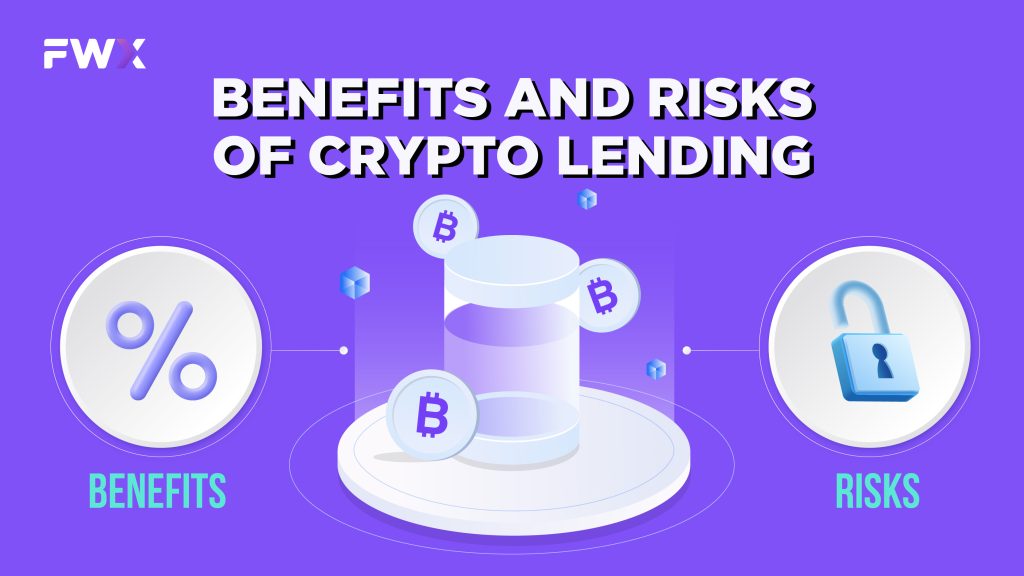
Benefits of Crypto Lending:
- Higher interest rates: Crypto lending platforms typically offer significantly higher interest rates on deposited crypto compared to traditional savings accounts. This can be a lucrative way to earn passive income on your crypto holdings.
- Access to cash without selling: You can borrow cash or stablecoins against your crypto collateral without having to sell your digital assets. This can be useful for meeting short-term financial needs while holding onto your long-term investments.
- No credit checks: Unlike traditional loans, crypto lending often doesn’t require credit checks. This makes it accessible for individuals with poor credit or those who are unbanked.
- Faster loan approvals: The approval process for crypto loans is often faster and more streamlined than traditional loans, with funds available within minutes or hours.
- Greater privacy: Crypto lending platforms typically require less personal information compared to traditional banks, offering a higher degree of privacy for borrowers and lenders.
Risks of Crypto Lending:
- Volatility: Cryptocurrencies are highly volatile, meaning their price can fluctuate significantly. This can lead to margin calls, where you need to deposit more collateral to maintain your loan-to-value (LTV) ratio or risk liquidation of your assets.
- Platform risk: Crypto lending platforms are still a relatively new industry, and some may be subject to security breaches, technical issues, or even insolvency. It’s crucial to choose a reputable platform with robust security measures.
- Regulatory uncertainty: The regulatory landscape surrounding cryptocurrencies is evolving rapidly. This can create uncertainty and potential risks for crypto lending platforms and their users.
- Counterparty risk: In peer-to-peer lending, there’s a risk that the borrower may default on their loan. This can lead to financial losses for the lender.
- Smart contract risk: Decentralized lending platforms rely on smart contracts, which can be vulnerable to bugs or exploits. This can lead to unintended consequences for users.
In conclusion, crypto lending presents a dynamic and evolving landscape for earning passive income and leveraging your digital assets. Whether you’re a borrower seeking swift access to cash or an investor aiming to maximize your crypto portfolio’s potential, understanding the intricacies of crypto lending and DeFi is crucial.


